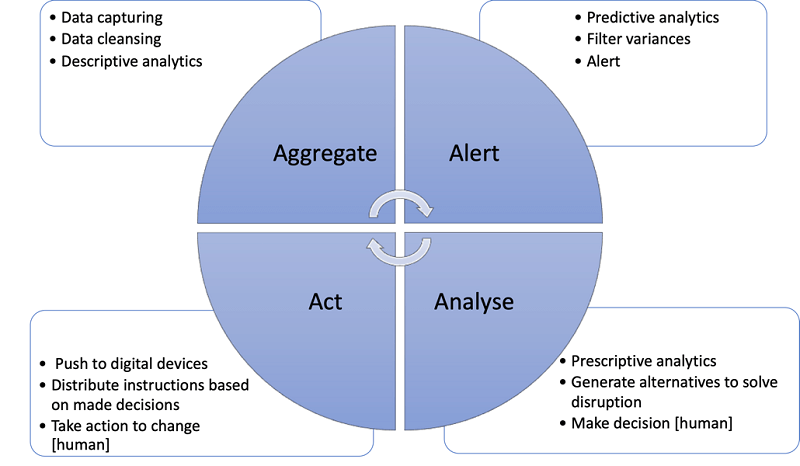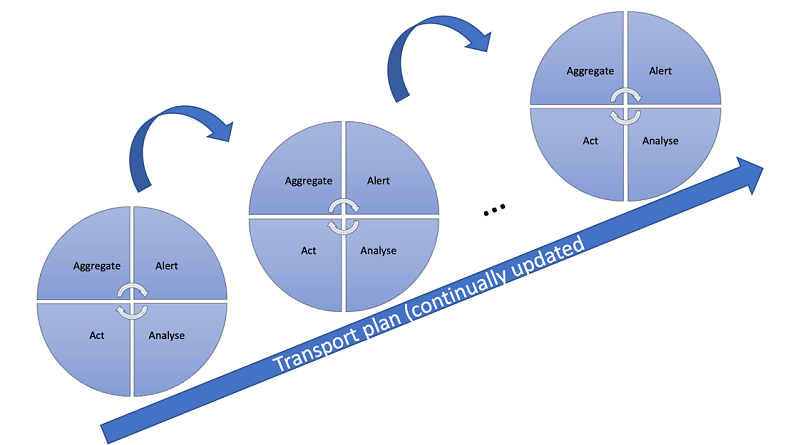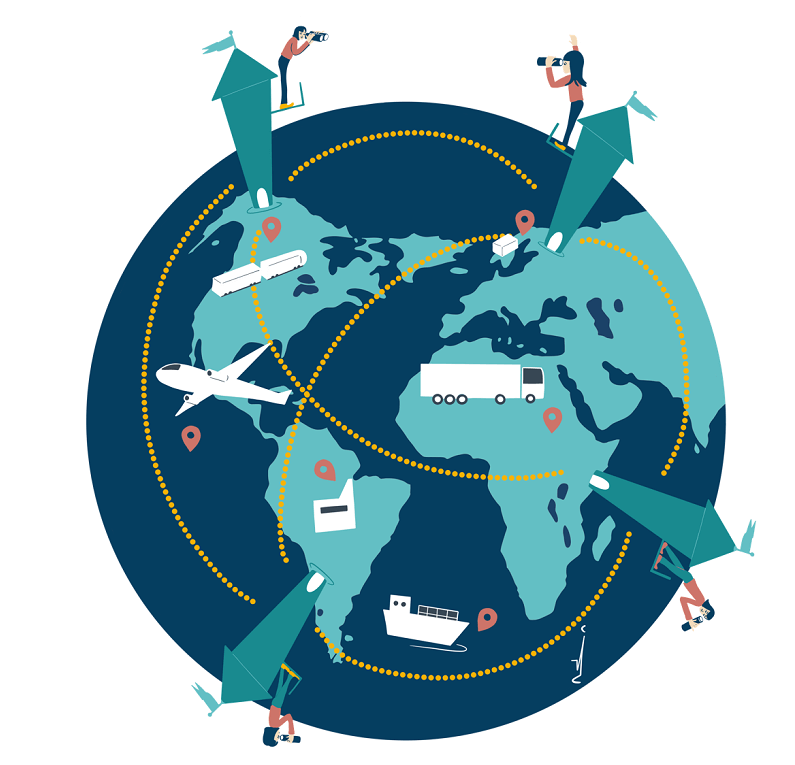Virtual Watch Towers for Supply Chain Visibility

Cargo owners and transport buyers wish enhanced visibility and forecasts on the times of goods and (returnable) assets arrival at various locations in the global end-to-end multi-tiered supply chain network. Logistics service providers also do need to stay informed on progress and disruptions on the activities related to their cargo. Carriers can benefit from visibility before and after their activity. Given the vast amount of data that now are becoming released through diverse data streams there lies great opportunity to achieve enhanced situational awareness for the involved parties and the clients of multi-modal transport chains. Virtual watch towers, which are pieces of software pull data together for analysis to create business value, like the location of assets and goods or higher on-time arrival compliance.
Watch tower defined
The term ‘tower’ is often used to mean that one may have an overview of operations for a defined scope providing means to act in a smart way. Although the virtual tower is not a physical building overseeing operations in the sky like the surveillance towers at airports, the purpose is similar. A virtual tower is a piece or suite of software to be used to provide situational awareness. In the case of the virtual value chains watch tower, such situational awareness is focused on end-to-end visibility built on the large amounts of data that is gathered from numerous feeds and which is analyzed continuously to identify delays and risks, find and prioritize mitigating measures and empower people in the organization to avoid disruption and ensure compliance. The virtual watch tower is a digital agent that uses descriptive, predictive, and prescriptive analytics for enhanced decision making and exception management. It also orchestrates the heterogenous data streams, deals with organisational issues and ensures the operational business alignment of different actors toward the supply chain goals.
The purpose of a watch tower is to provide a greater level of knowledge about the entire picture and specific events to every link of the supply chain. Virtual watch towers use cloud-based intelligence and analytics to not only detect risks and variances to plan but derive the best course of action to mitigate the identified risks or correct deviations and prevent them from happening again. The revolutionary push from reactive to proactive behavior is at the heart of the virtual watch tower.
Towers for the transport industry
During the last decades as digital technologies like cloud, blockchain etc. have become more advanced and widely deployed, more virtual approaches to tower capabilities have been established with the development accelerating recently. Within road, rail, and sea transport we have been seeing both public and private initiatives to establish situational awareness of operations within a particular geographical area, for a transport hub, and/or a particular corridor or fleet. There are also initiatives taken of which maritime cargo is possible to track and trace through platforms like Tradelens. Other insight providers with varying focus and approaches are Blume, FourKites, Project44, Roambee and Tive. They all are building upon enhanced digital connectivity and big data.
Different types of supply chain control towers have emerged over the years. A first generation of such towers were brought to use in the 1990’s which were limited to logistics operations, and were more reactive than proactive, only working on normalizing operations when there was a disruption that someone spotted. Those however suffered from lacking verifiability and connectivity across the supply chain. The second generation were aimed at more operational control and provided near real-time data on fleet locations, inventory levels, as well as custom alerts when exceptions or anything that affects overall supply chain performance occur. This generation of supply chain control towers however suffered from manual processes, lack of end-to-end and multi-tiered perspective, uniformity, and information overload. The third generation took the end-to-end logistics and supply chain control into the scope. That generation however suffered from lack of adequate or uniform infrastructure (technology, connectivity), manual intervention required for exception handling, and shortcomings in prescriptive analytics along the entire value chain of a company. The fourth generation puts more emphasis on automation and better analytic capabilities.
Important is to distinguish between the different types of control towers, like logistics/transportation control towers, fulfilment control towers, inventory control towers, supply chain assurance control towers and end-to-end (E2E) value chain control towers. Some are custom-built by large enterprises, others are provided by vendors, for example forwarders to act on behalf of their customers based on standard operating procedure (SOPs). This contribution reflects on logistics/transportation control towers.
As supply chains are global, there is a need for a framework that is holistic in nature and that guides the developments of watch towers throughout the world. We use the concept of “watch” tower, rather than “control” tower, to stress the importance of the need for building smart decisions on rich sets of data constituting situational awareness.
Foundational model for the global supply chain “watch tower”
The proposed underlying model for the virtual watch tower builds upon a digital agent that detects actual or future supply chain disruptions. In its processing, the agent takes numerous data streams into consideration cleanses the data to detect the transports/transport or upstream and downstream value chains that have been negatively impacted and/or are likely to be disrupted in relation to planned transports and transports being conducted. On the flipside, the watch tower will not surface those activities that are expected to be pursued as planned with a high degree of probability. Fundamentally, the watch tower is therefore to build upon data covering planned times, estimated times, and actual times, i.e. plan vs. progress and plan vs. anticipated progress. As digitalization allows us to detect multiple instances and calculate multiple outcomes, emerging choke points can be identified in advance, as e.g. congestions occurring at particular transport nodes, like ports and terminals can be detected hours, days or even weeks in advance given that it would be possible to achieve situational awareness through analysing vessel data or run simulations of how many transports are expected to be served at the same time at a particular node. Of course, this may need some time to reach a high level of accuracy. Once the digital agent has detected a potential variance to plan, the engine can calculate alternative options which the agent can prioritize to prescribe the one with the most promising outcome based on pre-set parameters or rules, e.g. on-time and in-full (OTIF) delivery at minimal costs. The agent triggers action, either through an automated process or by guiding people through the distribution of deviation and risk alerts and identified best possible alternatives.
The model that guides the composition of the watch tower is divided into four activity components; aggregate, alert, analyse, and act (figure 1). Within these components, the digital agent would pursue most of the tasks, while humans would rather monitor and execute on the recommended options. The human influence on the process should be limited to validating conformity with the rules, ensuring proper system performance, and to factor in last-minute information.

Figure 1: Fundamental model for the watch tower
The model uses the current transport plan for one actor covering its transports within the scope of interest. The plan can cover a particular piece of a multi-modal and multi-tiered value chain or the whole chain dependent on the scope of the operations that the actor is engaged in. An example could be a fleet operating center of a shipping company that may be concerned with transports from one port to another, but it may also concern a transport buyer requesting a multi-modal transport. Or it could be about the entire value chain of a certain company, covering a network of upstream suppliers and the transport legs in-between. The transport plan should both capture data about the cargo being transported, the points and timing of departure and destination, and the routes that are planned to be taken by the logistics service provider. This since possible decisions of re-routing and mitigating actions need to take the characteristics of the cargo and the original plan into consideration. The transport plan is dynamic in the sense that it both continually captures new planned transports and also reflects decisions of changes, and also new suppliers in the extended network.
The different action components of the model can be unpacked in the following aspects:
- The aggregate component takes the maximum number of data feeds into consideration that may be of relevance for the transports depicted in the transport plan and supplier network. This component also entails the cleansing of the data through artificial intelligence/machine learning (AI/ML) features.
- The alert component continuously scans the cleansed “watch” data and produces signals that point to potential disruptions or deviations with potential impact on the transport plan. This component uses thresholds, such as temperature ranges or an expected arrival time at an intermediary transport node.
- The analyse component produces for each signal with the help of AI/ML a list of alternative options (if available) that could be adopted according to known parameter, e.g. shifting to a truck instead of using the planned train to ensure compliance with the transport plan.
- The act component, which is an operational function that provides machines or humans with the agent’s findings to take effective measures, such as re-routing a truck or selecting an alternative parts supplier.
Different digital components are reflected in contemporary solutions such as control tower functions, as e.g. adopted by Maersk, focusing on data provision and dashboards as foundations from which customers can optimize their supply chain to the next level or solutions for distributed data collection and aggregation, such as The Flex pulse mobile solution, populating situational awareness for the Flex situation room facilitating collaborative problem solving among the operators along the supply chain.
The watch tower is a continual model of which actions taken in one cycle constitute the new plan for the second cycle etc. The model also takes new transport assignments into consideration through which it becomes continual. The digital agent is continuously evaluating the transport plan and when thresholds are reached it identifies alternative options and recommends those that improve the outcome. This is closely linked to procedures of sequential decision-making which continuously evaluate the situation the further one gets into the transport chain, i.e. decisions are improving with the growing about of information. This would mean that the model of aggregate-alert-analyse-act would be pursued iteratively (figure 2).

Figure 2: Iterations of cycles as foundational for the watch tower
An emerging landscape of data streams
We expect an exponential growth of data streams. The watch tower builds upon that the “aggregate” component is fed by numerous data sources, like internal systems and external data sources. Data can stem from in-house or partner systems or from connected devices. Video streams can provide node intelligence capturing data streams that provide real-time context on what is happening at certain nodes. We need to distinguish direct data gathered first-hand, e.g. sensor and video data, and in-direct data streams for example milestone-based check-ins. Direct data is more granular than indirect data. Complementary data sources may capture the same thing, such as the bridge system of a ship providing data on position, heading, and planned time of arrival but also internet of things (IoT) sensitized containers being onboard the same ship providing data on its position. The development of VDES satellites is going to foster the full connection of vessels across the world. There are also a multitude of radio frequency identification (RFID) readers settled along e.g. railroad trucks in Europe to allow for real-time updates when a train wagon passes a particular location.
Computer processing capabilities now allows to generate event data from video streams, such as a truck entering a transport node zone or a crane operating containers, such in the case of the Kalmar ONE solution providing event data based on camera data. An obvious data source within the maritime supply chain is automatic identification systems (AIS) that may be used as a foundation for generating event data to be shared, but we will thus also see new data streams emerging from the detection of e.g. container ID’s captured by video streams and analyzed through computer vision techniques. Monitoring of online news, governmental agencies, weather stations, social media and other institutions can create external event-based data indicating a heightened risk of delay in a particular node of the supply chain. External event data informs about natural disasters, weather, strikes, bankruptcies, pandemic/health or even war. Finally, watch towers can leverage AI models that detail the multitiered aspects of value chains in order to address potential bottlenecks upstream in supply chains and thereby gain valuable time.
Situational awareness may become populated with multiple data sources allowing the virtual watch tower to operate in the most effective way.
Interacting watch towers providing situational awareness for all
This foundational model for watch tower functionalities could be adopted by stakeholders across the global supply chain network creating a network of virtual watch towers exchanging information between each other. One watch tower sits on pieces of data that are a useful data stream for other watch towers allowing them to identify, mitigate and act upon risks and deviations from plan beyond their scope of operation. When there are multiple virtual watch towers along the same supply chain there would be a lot of value through providing data for broader analysis that would surface more risks and deviations than one single tower (figure 3).

Figure 3: Network of virtual watch towers (Illustration: Sandra Haraldson)
The result is a community of prosumers of data, as everyone that establishes a virtual watch tower would be both producers and consumers of data.
Connecting ports is not new. The Singapore port for example is linked to 600 ports in over 120 countries. But connecting watch towers would be an innovation. There are also initiatives taken by e.g. the Digital Transport Logistic Forum (DTLF), the FEDeRATED project, the International Port Community Association (IPCSA) to facilitate the distribution of data between local data sharing communities, and now by the US department of Transportation responding to supply chain challenges with increased data sharing.
Concluding words
Empowering supply and value chain visibility with logistics/transportation and other types of watch towers is made possible due to an ever-increasing computing power and distribution of data across the globe. People become more connected which also allows for people using mobile devices to feed systems with data about what they see and achieve, but they can also receive on the same devices recommendations from virtual watch towers to act upon. In this article we propose a network of logistics/transportation watch towers to meet the demands of 1) cargo owners and transport buyers to get more insights in the progress and how disruptions are managed that may affect the arrival of their goods, and 2) enhanced situational awareness for logistics service providers allowing to manage cargo flows more efficiently. While carriers themselves also benefit from enhanced E2E visibility they may face questions from their customers about some routing made visible through the higher level of transparency.
Watch towers empower just-in-time operations across the supply chain optimizing on time, space, and resources as well as optimizing for sustainable operations with as little CO2 emissions as possible. Shipping is global and digitalization enables seamless interaction across the globe and as more and more data streams are made available and more sophisticated filtering and analytic tools are being developed proactive management of supply chain is increasingly possible. Connecting watch towers for supply chain visibility in a network of smart centers around the world will lift the concept of control towers to a totally different level. The authors invite practitioners and academics to provide their views on the topic and ideas how this promising concept can be brought to life.
About the authors
Mikael Lind is the world’s first Professor of Maritime Informatics and is engaged at Chalmers, Sweden, and is also Senior Strategic Research Advisor at Research Institutes of Sweden (RISE). He serves as an expert for World Economic Forum, Europe’s Digital Transport Logistic Forum (DTLF), and UN/CEFACT. He is the co-editor of the first book of maritime informatics and the follow-up book recently published by Springer.
Wolfgang Lehmacher is operating partner at Anchor Group. The former head of supply chain and transport industries at the World Economic Forum and President and CEO Emeritus of GeoPost Intercontinental is advisory board member of The Logistics and Supply Chain Management Society, ambassador of The European Freight and Logistics Leaders' Forum, and founding member of the think tanks Logistikweisen and NEXST.
Sandra Haraldson is Senior Researcher at Research Institutes of Sweden (RISE) and has driven several initiatives on digital collaboration, multi-business innovation, and sustainable transport hubs, such as the concept of Collaborative Decision Making (e.g. PortCDM, StationCDM, YardCDM) enabling parties in transport ecosystems to become coordinated and synchronised by digital data sharing.
Andre Simha is Global Chief Digital & Information Officer of MSC Mediterranean Shipping Company, a global leader in container shipping and logistics. André believes the container shipping industry's future depends on its ability to innovate and use digital technologies to simplify processes and unlock value for customers. André is also Chairman of the Supervisory Board of the Digital Container Shipping Association (DCSA).
Tobias Larsson is the Head of Supply Chain at Altana. Altana is a Trusted Commerce Platform, enabling businesses and governments to connect and collaborate through a shared source of truth for the global supply chain. Previously, he was the initiator and CEO of Resilience360, a solution for supply chain risk management, incubated at Deutsche Post DHL (today Everstream Analytics).
Berit Hagerstrand-Avall is Head of Sea Logistics in Stora Enso. Part of the global bioeconomy, Stora Enso is a leading provider of renewable products in packaging, biomaterials, wooden construction and paper, and one of the largest private forest owners in the world. Berit has more than 25 years of experience in global container shipping and logistics. She believes that end-to-end supply chain visibility through multimodal transparency is the key to success in global business.
Magnus Lyrberg is Senior expert in digital innovation and logistics at Research Institutes of Sweden (RISE) and has driven several initiatives on digital collaboration and digital transformations. Magnus have a developed global control tower transport solutions at DHL and have more than 25 years in the transport industry and IoT.
Dr. Phanthian Zuesongdam is Head of Division Port Process Solution and smartPORT Program Director, responsible for New Business Development for the Hamburg Port Authority (HPA). She is an experienced lead digital strategist and transformation manager in the maritime and port industry. Before she worked with international organizations like UNESCAP, Lufthansa Cargo and BP.
Scott Hurley is VP of Product Marketing and Strategy for Roambee, a sensor-driven supply chain visibility vendor. Scott has over 15 years’ experience in applying location intelligence to transportation and supply chain industry challenges.
Xiuju Fu is Senior scientist and Group Manager at Institute of High Performance Computing, Singapore. She has been active in developing and applying big data intelligence, simulation and optimization techniques for complex system management. She had led multiple projects in maritime operation efficiency and traffic safety, public health and supply chain risk management.
The opinions expressed herein are the author's and not necessarily those of The Maritime Executive.
